On the Verge of a Liquidity Event
The upcoming reserve drain will flow throughout dollar funding markets, blowing up the cash-futures basis trade and creating safe-haven positioning that spikes the dollar’s FX.
A soaring dollar in FX terms and an unsteady Treasury market would contradict protectionist goals of the incoming Trump administration and stability goals of to the Fed, respectively, giving both a shared incentive to weaken it. The most direct and impactful way in which officials can weaken the dollar and restore stability to the Treasury market is by encouraging a new end investor to narrow interest rate differentials between foreign bonds and U.S. Treasuries.
The 'new' end investor will most likely be commercial banks armed with balance sheet relief for Treasuries. But that regulatory change will not come until the situation absolutely demands it – what I call "the dealer's Armageddon", as unfolded in March 2020.
Here, the mechanics of the reserve drain leading to a basis trade unwind, and how this flows through the dollar system, from Treasuries to stocks to FX to gold, are analyzed in much greater detail than they were last month.
For some months, I’ve described how the structural issues in the Treasury market – namely that dealers have increasingly shallow warehousing capacity for repo financing – foretell an inevitable return to the cataclysmic funding conditions of March 2020. While there has been some improvement, like the proliferation of sponsored repos that free net balance sheet space, these changes are like steering the Titanic after it’s hit the iceberg. Sweeping changes are what’s needed, and sweeping changes don’t come without cause.
The market for trading cash Treasuries isn’t like the stock market, where a broker connects buyers with sellers. Instead, it’s like the options market, where a dealer takes the opposite side of all trades: buying from sellers and selling to buyers. A pension fund can’t sell a Treasury directly to a mutual fund, for example. In the interdealer market, which is about half of all volumes, they buy and sell amongst themselves, providing liquidity that helps stabilize yields.

These dealers tap the overnight (o/n) repo market to finance their purchases. Recall, a repo is a cash loan secured by Treasury collateral. To repo finance his inventory, the dealer will buy a Treasury from a seller and simultaneously post it as collateral in a repo loan. The repo loan finances most of the original purchase and is unwound once the dealer finds a buyer.

Not unique to Treasuries is that, to function properly, there must be an ultimate buyer (a.k.a. an end investor) willing and able to hold the security during times of stress, else volatility can snowball. Dealers are not ultimate buyers – they are intermediate buyers (market makers) whose entire strategy hinges on finding a buyer to offload the Treasury to.
But even when conditions appear mild, ultimate buyers don’t always buy. Banks and non-banks are price sensitive buyers – they only buy if it makes sense to buy. Factors such as the yield curve and term premia determine if it makes sense to buy Treasuries, and, if the answer is no, primary dealers still have to buy, because hell or high water, the Primary Dealers Act of 1988 requires them to.
The concept of an end investor is important because dealers’ ability to make markets in Treasuries is not infinitely elastic – their balance sheet activity is limited by an alphabet soup of leverage ratios (SLR), resolution liquidity (RLAP) and capital requirements (G-SIB surcharges). In other words, under Basel III, they can’t be expected to absorb everything. If there were enough end investors in March 2020, then dealers would have just offloaded securities as usual and there would not have been liquidity issues. But at the time, the combination of a lack of end investors and a furious barrage of selling was enough to push dealer balance sheet capacity over these limits, and, after a daisy chain of forced selling, the Fed stepped in.

If dealers are left to absorb a large supply of issuance (plus taper as the Fed lets Treasuries run off its balance sheet) and they finance this supply in o/n repo, the risks shift to the repo market, which becomes especially sensitive to cash shortages and, importantly, “balance sheet shortages.” More Treasuries warehoused by dealers will mean more demand for that inventory to be financed, and, without that, o/n rates – the anchor of the financial system – are sent higher and start to become volatile.
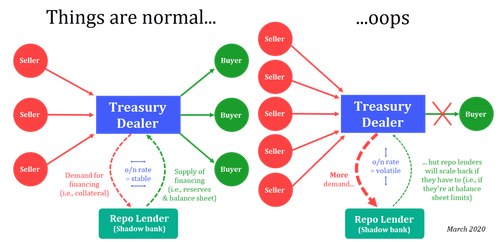
A cash shortage was essentially what happened on September 17 2019 when, in the Fed’s own (very mild) words, “there were more Treasury securities to be financed in the market that day with relatively less cash.” The result:
Yesterday it was repo. Today it is SOFR
— zerohedge (@zerohedge) September 18, 2019
Plumbing is collapsing before our eyes pic.twitter.com/AMyf8ppLXj
The Fed would like to think that its relatively new repo facility creates a hard ceiling on rates – they are a risk free counterparty and have no limits, cash or otherwise, on their ability to lend. But its imperfections were exposed at quarter-end last month when $600 billion was borrowed above the Fed’s offering rate – Fed repos went underutilized due to stigma and a timing misalignment.
The mechanics are esoteric, but the way to understand the Fed’s o/n repo facility is that it’s intended to make the Fed a dealer of last resort, which it did, but not necessarily to create a hard ceiling on repo rates.
oops pic.twitter.com/M0CfWxV16t
— zerohedge (@zerohedge) October 1, 2024
The “supply of cash”, and terms like “cash shortage”, should be thought of as the supply of financing, of which there are two components. The obvious one is the supply of reserves – cash used by banks to settle transactions. The less obvious one is the supply of balance sheet. A dealer's balance sheet is like an office building – it can only hold so many tenants (assets), and its bank wants to use that limited space to accommodate the most profitable it can get. The size of the building, and the size of each tenant's footprint in the building, are set by leverage ratios like the SLR.
The reason to think about March 2020 instead of September 2019 is because a reserve shortage, where the Fed responds by printing new reserves in QE, is not on the horizon for now, but a balance sheet shortage is already here and waiting to be exposed. As I explained last month, if there was a shortage of bank reserves, you’d have higher intraday bank overdrafts, more late payments, and a more volatile Fed funds rate (indicating more borrowing of unsecured reserves).
Instead, bank liquidity, measured by everything except Treasury intermediation, doesn’t get much better than this.
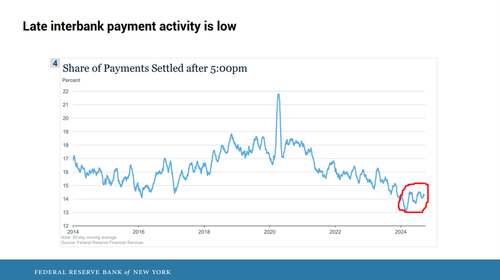
The former, reserve scarcity, can come and go with nobody noticing – in September 2019 equities couldn’t care less about what the repo market was doing – partly because the New York Fed easily stymied those pressures in 15 minutes. But the latter, where market makers’ balance sheet become distended, is violent, quickly spills over into every asset class and can be misinterpreted by the Fed.
This is why the end investor is critical…
… Because there is a conceptual problem with the way hedge funds are providing demand. They are not end investors, and at no point in their trades is there an end investor willing to buy and hold in exchange for reserves. For all the credit they get as marginal buyers, the liquidity provided by their arbitrage is illusory end-demand.
Take the cash-futures basis trade for example, where a hedge fund buys an illiquid cash Treasury from a dealer and shorts a Treasury futures contract, seeking to arbitrage the tiny difference (i.e., the “basis”).

The size of the basis trade is clearly large enough to provide liquidity, but mechanically, there are no end investors at any point in the trade. The asset managers who buy Treasury futures prefer them over cash Treasuries because futures are operationally simpler and have less impact on their expense ratios. When those futures contracts mature, and the long position is obligated to take delivery of the security, the Treasury is sold back to a dealer and the proceeds are rebalanced back into the futures.

So, while the trade does provide enough liquidity to prevent yields from spiking in the face of epic supply, the security itself just goes around in a circle, shuffled between the balance sheets of different dealers. Not only that, but this demand will completely disappear and go into reverse where the hedge funds become forced sellers if volatility were to widen the basis and margin call the fund’s highly-levered position. That's exactly what happened in March 2020, when “the sale of Treasury positions by RV funds exiting their basis trades and their sudden role reversal from net buyers of less liquid Treasury securities to net sellers” made bad dislocations worse.

Now’s not the time for higher capital costs and increased margin requirements – it’s time to lean on the suitable end investors who don’t fire-sell bonds at the first hint of volatility. But you can’t just pull an end investor out of a magician’s hat – you must encourage them with higher yields or with regulatory relief. Uncle Sam will admit that it can’t afford the higher borrowing costs, and while regulatory relief has been teased, expect nothing to be concrete or effective absent a ‘SHTF moment’.
The long-standing assumption is that, with an inverted yield curve like we’ve had for two years, it makes no sense for price-sensitive investors to buy Treasuries on the margin, and that’s when dealers buy. But with a steep (normal) yield curve, banks, non-banks and “real money” investors such as pensions and life insurers will be enticed to swoop in as end investors, buying $100s of billions in Treasuries and freeing up enough space for dealers to repo lend their reserves and make markets in Treasuries.
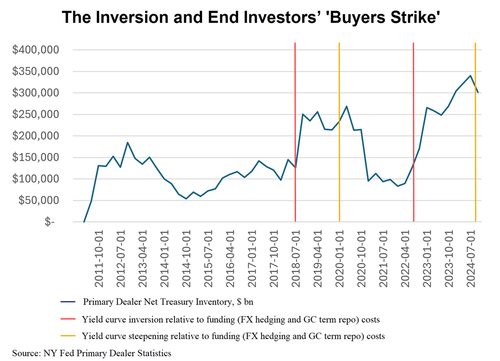
But that assumption is dated to 2019 and before, and there are problems with it…
Pension funds have historically favored riskier, growth-oriented investments like equities to meet aggressive return targets. Life insurers, despite their focus on fixed income, allocate only small portions of their portfolios to Treasuries, preferring higher-yielding assets like corporate bonds and mortgages that better match their liability structures and offer a liquidity premium they can harvest.
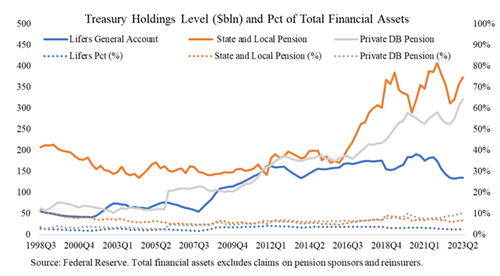
Diversification mandates further limit real money investors' capacity to increase Treasury holdings. Public pension funds, for instance, operate under strict asset allocation targets that constrain flexibility, with CalPERS, the biggest U.S. public pension, capping Treasury exposure at 7%. Even with regular inflows, the best result is incremental Treasury purchases that fall far short of what’s needed.
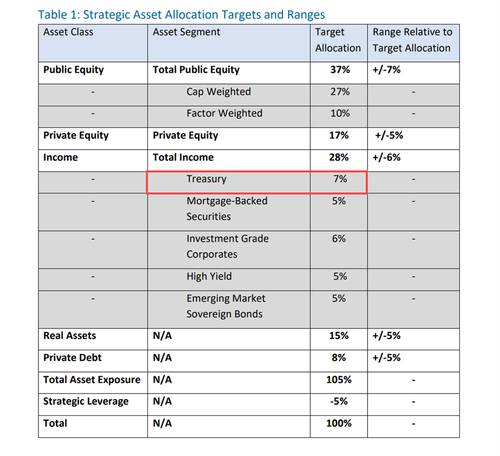
The same also applies for the most part to sovereign wealth funds and foreign pensions, who have enormous Treasury portfolios but are slow to respond. There was a good piece recently shared onto zerohedge that assumes the Japanese will come in to buy $100s of billions of Treasuries from dealers. If the yield curve were steep – really steep – then sure, FX-hedged foreign investors would likely buy enough such that, at a minimum, it could provide some relief for dealers and, thus, on o/n rates.
But a ‘really steep’ yield curve is not a couple of basis points – you need the 10-year to rise to 5%, three+ rate cuts, or both. The reason Japanese FX-hedged investors won’t buy tons of bonds is because much of that longer-dated yield is term premia. They’d be better off buying short-term bills and getting the same return.
Not to mention that any bond rally without deep rate cuts would invert the curve further…
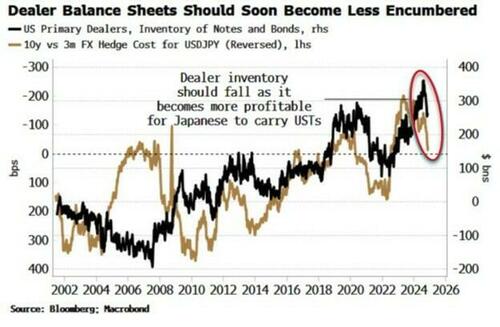
What about the obvious choice – the banks? Commercial banks admit they would gorge on Treasuries if they had the balance sheet space. They did start buying in this past year, but only because loan growth had slowed, freeing up space. Bank lending came to a standstill amidst aggressive hikes and last year’s bank failures, but now looks to be resuming as the market gets and anticipates more rate cuts.
Nothing about what’s worked over the last 18 months has to necessarily change – dealers can continue buying and hedge funds can continue trading with dealers, for now. It takes volatility – selling – for this balance to unravel. In 2020 the trigger was a global lockdown that prompted a dash for cash – global margin calls on missed payments saw an equally universal demand for cash, which spiraled out of control. Dealers were forced to buy, but unable to source repo financing, became net sellers – a vicious cycle of widening bid-ask spreads and spiking yields commenced.
What could possibly cause the safe-haven asset to go on sale in 2025?
Last month in Countdown to QE I explained how because asset performance has been doing so well in 2024, the April 2025 Tax Day revenues will likely be historic. Tax payments are settled by the banking sector, so historic receipts would mean a historic drain on bank reserves (see here). It’s difficult to estimate the size this far in advance, but unless bitcoin & equities are obliterated into Christmas, $700b or more is my best guess. Much bigger than the $500b Tax Day in 2022, because quarterly tax receipts are tied to asset performance from the prior year, and GDP has grown over 20% since.
$700b or more in liquidity pulled from the banking system over two weeks is a lot…
There’s no other way to put it. For scale, most period-end window dressing pressures are to the tune of ~$200b, which, if you’re nearing the LCLoR, is enough to spike o/n rates:

The way to think about the coming liquidity event is not reserve scarcity in the absolute sense, but balance sheet scarcity that’s suddenly made much worse with sharply fewer reserves.
Reserves are the highest form of bank liquidity. With less, banks must prioritize their remaining balance sheet space. But o/n repos have some of the lowest profit margins and carry some of the highest gross balance sheet costs, which explains why repo pressures start mounting as reserves approach the $3 trillion LCLoR, even if it’s just the ‘quarter-end effect’.
Sponsored repos, where the FICC takes both sides of both trades, are intended to free up this balance sheet space, which is positive for liquidity. And indeed, that’s what it’s done. By allowing dealers to “net” their repo trades (the net exposure of sponsored repo borrowing is “cancelled out” by the net exposure of sponsored repo lending), net balance sheet space is opened up.

But it’s not perfect. The balance sheet constraints for dealers appear to be moving to those that would not be solved by central clearing. The image below shows how sponsored repo reduces net balance sheet size, but not gross size. Some regulations, such as the Net Stable Funding Ratio (NSFR), assess net balance sheet exposures, while others, like the GSIB Short-Term Wholesale Funding score and the leverage ratios, focus on gross exposures.

The reason these pressures didn’t appear in late 2022 – the last time reserves tested $3 trillion – is because dealers weren’t left to finance and warehouse nearly as much inventory. But since then, the inverted yield curve forced them to buy, and repo volumes (SOFR volumes) began to surge as hedge funds demanded the financing for their trades.

There’s only a handful of reasons why reserves would decline suddenly and sharply: period-end window dressing or payment settlements (auctions or taxes) with the Treasury. Period-end repo pressures are expected. They’re also transitory since, once that reporting period passes, the reserves are immediately re-deployed back into repo. Reserves drained due to tax receipts, however, don’t reenter the banking system, at least immediately.
As explained here last month, the quickest fix that’s most likely to be pursued by regulators is an exemption of Treasuries and Treasury repo from the Supplementary Leverage Ratio. That would give the banks “bottomless balance sheets” and is exactly what they decided at the depths of the Covid shock. It would immediately provide a new end investor without the bad optics of the Fed, and put downward pressure on interest rates.
The safe asset – U.S. Treasuries – is being funded o/n and therefore it depends on balance sheet to fund it. Balance sheet isn’t guaranteed after a “historic” reserve drain, and if the balance sheet won’t be there, the safe asset will go on sale…
… Yields will spike, and the cash-futures basis will widen, prompting a vicious cycle that begins and ends with Treasury dealers.
The way this plays out is for dealers to, first, be left with less capital to deploy as leverage ratios like the SLR bind their balance sheet and force them to retrench from repo activity. They make up for the balance sheet constriction by imposing higher o/n financing rates and larger haircuts (margin requirements) on hedge funds, effectively crowding out all but the most well-capitalized names like Citadel and Millennium. Those unable to compensate for higher trade costs would unwind their basis trades, selling Treasuries, making the illiquid off-the-run bonds that they once owned even less liquid and even more difficult to trade.
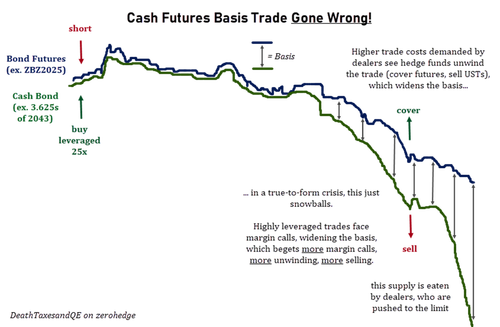
As the cash-futures basis widens due to continued unwinds, this would ultimately see the most well-equipped hedge funds like Millennium retrench from their trades. Margin calls pull away capital from dispersion and long/short equity strategies in what amounts to an equity selloff during a Treasury selloff – the most dreaded kind of risk parity.
Dealers, forced to free up balance sheet capacity, after pulling back from low-margin repo activities, themselves become sellers...
... selling to other dealers.
This heightened turmoil and rising yields would see the dollar’s FX spike – contradicting trade goals of the Trump administration. It’s not only ‘arch protectionist’ Robert Lighthizer, the incoming chief trade advisor, who plots to fight the trade war with a weaker dollar, but the incoming Treasury Secretary Scott Bessent had this to say:
“Another differentiated view that we have is that Trump will pursue a weak dollar policy rather than implementing tariffs. Tariffs are inflationary and would strengthen the dollar - hardly a good starting point for a US industrial renaissance. Weakening the dollar early in his second administration would make U.S manufacturing competitive. A weak dollar and plentiful, cheap energy could power a boom. The current Wall Street consensus is for a strong dollar based on the tariffs. We strongly disagree...”
Not to mention that Trump has been a long-time advocate for lower interest rates.
The biggest risk is for the new Congress to immediately suspend the debt ceiling and for the Fed to panic and restart ‘real QE’: injecting reserves when more reserves are not what’s needed. Even worse would be to restart QE without tweaking the leverage ratios. I have a hunch that Powell wants to avoid the bad optics of central bank involvement, making ‘real QE’ unlikely, but who knows. It’s also well known that when it comes to a crisis, especially in Treasuries, Powell's Fed will shoot first and ask questions later.
The way this goes most smoothly is for the new Congress to wait to suspend the debt ceiling in the summer, after Tax Day, and to rapidly spend down the TGA, a move that will support bank liquidity. More importantly, regulators will exempt Treasuries and Treasury repos from the SLR, ushering in ‘bank-QE’ where the commercial banks, now outfitted with war-time balance sheets, become permanent marginal buyers. The Fed will expand repo operations by simply uncapping the o/n repo facility and opening it a few hours earlier in the day. Before then, likely in March, the Fed will have already ended QT.
These fixes are extremely straightforward, but have permanent consequences, so officials are in no rush to exercise them.
Since there’s interest in how to trade it, I would just suggest the March 2020 playbook exactly, but with two caveats, in bonds and in gold. It would be the time to go long bonds (or cover bond shorts), the opposite of 2020 when yields were at rock bottom. When and if the Fed responds and banks start buying, bonds will rally.
In March 2020, the initial panic was gold negative, as offshore dollar borrowers met debt liabilities by selling assets (including gold) and exchanging local currency into dollars. But gold flows have changed since 2020 – today’s buyers are from the official sector, mostly in Asia, who aren’t so price sensitive and whose motives are more closely tied to geopolitics.

My base case is that gold is a safe-haven, and, without a 'dash for cash' due to lockdowns, what better time to bid for the safe-haven than when there’s acute dysfunction in the Treasury market?
A liquidity event in the U.S., whether it comes in April or before or later, would thus be positive for gold.
I'm writing and publishing this directly onto zerohedge and nowhere else. I read comments and try to answer questions.


